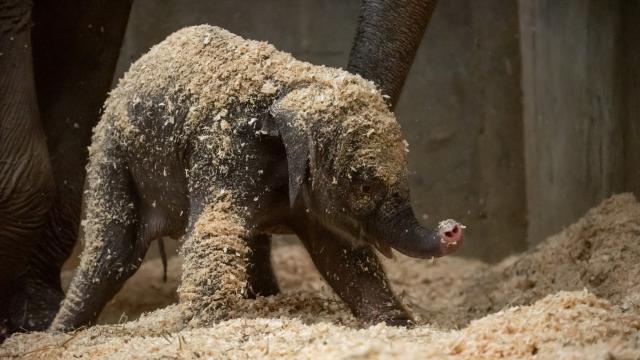There’s a new joke at the Columbus Zoo and Aquarium in Ohio: Who’s your daddy? It’s a genuine question for the female baby Asian elephant born early Thursday morning as a result of artificial insemination.
In March 2017, the calf’s mum, Phoebe, was inseminated with two male elephants’ sperm, which is standard procedure. But the team still hasn’t been able to confirm whether Hank or Samson is the father.
These things take time, you see. In fact, a team of vets with the zoo and the Ringling Brothers Center for Elephant Conservation inseminated Phoebe for the first time back in December 2016. She didn’t get pregnant then, so the team tried again in March. Elephants’ reproductive cycles give them only four chances a year at getting pregnant. Second time turned out to be the charm for Phoebe.
Now, she’s got a cute little bebe — her fourth, but first girl! The team went in Thursday morning to give the calf a quick examination, which included listening to its heartbeat and lungs, and drawing some blood samples. The exam took all of two minutes, said Randy Junge, the vice president for animal health at the zoo who was the lead vet on her case. The sex was confirmed Friday, but she’s still yet to be named.
New births like this are important for the species, which is endangered in the wild with less than 50,000 Asian elephants remaining, according to the World Wildlife Fund. These captive animals are unlikely to ever make their way to the forests of the Eastern Himalayas, but their DNA may.
Zoos often follow the American Species Survival Plan when breeding animals in captivity to help maximise genetic diversity. This program aims to improve conservation in the wild, and helps zoos determine what animals to breed. If one population is over-represented in the wild, for example, then zoos won’t have them make babies. But if a population is underrepresented, that’s reason to breed more.
“The idea is to maximise genetic diversity, which makes animals healthier and important for future generations,” Junge told Gizmodo.
Captive breeding programs can even help rescue species on the brink of extinction in the wild. That’s the case with the critically endangered Sumatran rhino, another Asian mammal whose population is around 80.
As for the Asian elephant, the current wild population stands at less than half of what it was at the beginning of the 20th century. Poaching and habitat loss are pushing this species to the edge and making them interact more and more with people, which can often wind up being deadly for the animals (and people foolish enough to hit an elephant with their car).
When visitors to the Columbus Zoo see the Asian elephants, they get to learn about the species as a whole and the plight it faces outside the zoo’s walls.
“Animals in human care are ambassadors for animals in the wild,” Junge said. “What we learn from them in care is helpful for elephants in the wild.”
